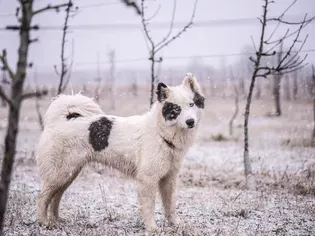Yakutian Laika: Dog Breed Characteristics & Care
Updated on 05/26/24

Unveiling the Yakutian Laika: A Journey into the Enigmatic World of the Siberian Sentinel
Introduction
In the frozen vastness of Siberia, where nature's grip tightens with unrelenting force, there exists an extraordinary canine companion: the Yakutian Laika. This ancient breed, forged by centuries of unwavering loyalty and hardiness, embodies the indomitable spirit of its homeland. With its striking features, exceptional hunting prowess, and unwavering affection, the Yakutian Laika has captivated the hearts of dog enthusiasts worldwide.
Exceptional Physical Attributes
Yakutian Laikas are medium-sized dogs, with males standing at a height of 21-23 inches (53-58 cm) and weighing between 44-60 pounds (20-27 kg). Females are slightly smaller, measuring 19-21 inches (48-53 cm) and weighing 33-44 pounds (15-20 kg). Their bodies are compact and muscular, allowing them to navigate the unforgiving terrain of their native habitat with agility and endurance.
A Coat Engineered for Survival
The Yakutian Laika's most distinctive feature is its thick, double-layered coat. The outer layer, composed of long, coarse guard hairs, forms a rugged shield against the elements. Beneath this lies a dense undercoat, providing exceptional insulation against the frigid temperatures of Siberia. This remarkable coat allows the Yakutian Laika to thrive in some of the most extreme environments on Earth.
A Striking Color Palette
Yakutian Laikas display a wide range of colors, including black, white, gray, red, and sable. Their coats often feature intricate patterns, adding to their captivating appearance.
A Temperament of Unwavering Loyalty and Independence
Yakutian Laikas are renowned for their steadfast loyalty and unwavering devotion to their owners. They form deep and enduring bonds with their human companions, showing unwavering affection and protectiveness. Their independent nature, however, means that they are not always the most obedient dogs. Yet, their intelligence and eagerness to please make them receptive to training with a patient and consistent approach.
Natural Hunting Instincts
Yakutian Laikas were originally bred as hunting dogs, and they possess exceptional skills in this regard. Their keen sense of smell and hearing, combined with their agility and endurance, make them formidable hunters in the Siberian wilderness. Historically, they were used to hunt a variety of game, including reindeer, elk, and even bears.
Examples of Hunting Prowess
* In a remote Siberian village, a Yakutian Laika named "Sasha" was known for her ability to track and bring down large elk.
* Another Laika, named "Tundra," demonstrated her exceptional hunting skills by successfully outwitting and capturing a bear cub.
Adaptability to Extreme Environments
Yakutian Laikas are remarkably adaptable to extreme environments. They have evolved to withstand the frigid temperatures of Siberia, where they endure sub-zero conditions with little discomfort. Their thick coat and sturdy bodies provide ample protection against the harsh weather.
Examples of Environmental Adaptability
* A Yakutian Laika named "Lena" accompanied her owner on a month-long expedition across the frozen Arctic, enduring temperatures as low as -60 degrees Fahrenheit (-51 degrees Celsius).
* Another Laika, named "Taiga," lived in a remote village where temperatures routinely dropped below -40 degrees Fahrenheit (-40 degrees Celsius) without showing any signs of discomfort.
Health and Care
Yakutian Laikas are generally healthy dogs with a life expectancy of 10-12 years. However, like all breeds, they are prone to certain health conditions, including:
* Hip Dysplasia: A condition where the hip joint does not develop properly, leading to lameness and pain.
* Elbow Dysplasia: A similar condition affecting the elbow joint.
* Osteochondrosis: A disorder that affects the cartilage in the joints.
Regular veterinary checkups, vaccinations, and a balanced diet are essential for maintaining the health and well-being of Yakutian Laikas.
Grooming Requirements
Yakutian Laikas have a thick, double-layered coat that requires regular brushing to prevent matting and tangles. Brushing should be done at least twice a week, and more frequently during shedding seasons. Bathing should be done only as needed, using a gentle shampoo designed for dogs.
Exercise Requirements
Yakutian Laikas are high-energy dogs that require regular exercise to stay happy and healthy. They enjoy long walks, runs, and playtime in a fenced-in yard. Providing them with opportunities to engage in their natural hunting instincts, such as chasing toys or retrieving balls, is also beneficial.
Training Considerations
Yakutian Laikas are intelligent dogs but can be independent and stubborn at times. Training should begin at an early age and be conducted with patience and consistency. Positive reinforcement techniques, such as praise and treats, are more effective than harsh methods.
Compatibility with Other Pets and Children
Yakutian Laikas are generally friendly with other dogs and can be good companions for children. However, it is important to socialize them early on to ensure that they are tolerant of strangers and other animals.
Suitable Home Environment
Yakutian Laikas are best suited for homes with large yards where they can run and play. They can also adapt to apartment living if provided with sufficient exercise and mental stimulation.
Conclusion
The Yakutian Laika is a truly extraordinary breed that embodies the resilience, loyalty, and unwavering spirit of its Siberian homeland. With its exceptional hunting abilities, striking appearance, and deep affection for its human companions, the Yakutian Laika has earned a place in the hearts of dog lovers worldwide. Whether you are an experienced dog owner or a first-time pet parent, the Yakutian Laika is sure to captivate you with its unique charm and unwavering devotion.
Explore More Pets

Basic Training
Puppy and Baby Introductions

Working Dog Breeds
All About Search and Rescue Dogs

Dog Treatments
Puppy Vaginitis: Signs, Causes and Treatment

Dog Adoption
After More Than 1,200 Days in the Shelter, Coco Goes Home

Basic Training
How to Train Your Puppy to Go on Potty Pads

Hybrid Dog Breeds
The Difference Between a Mutt, Mixed Breed, or Designer Dog?

Dog Treatments
Nail Problems in Dogs

Puppies
7 Reasons Why Two Dogs Are Better Than One
